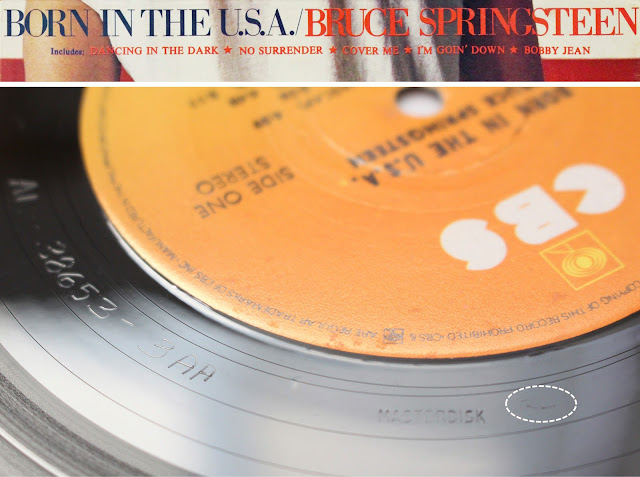 |
| The domestic release date (June 21, 1984) is stamped in red on the folded Japanese insert and given in the Japanese imperial year format [(Showa) 59 = 1984]. |
And then the Japanese pressings (CBS/SONY 28AP 2850 for test, sample and regular releases; 30AP 2878 for Mastersound issue). As shown above, compared with the early U.S. pressing, the test pressing has an obviously narrow dead wax space, and this observation is also true for the first pressing (shown here is a sample copy with an original vertical obi). Interestingly, the dead wax space of the second pressing (the issue with a horizontal obi) has become narrower than those of the test and first pressings, which means that it was pressed using newly cut master lacquers. This reflects the differences in machine-stamped matrix number suffixes (28AP-2850A1 versus 28AP-2850A2 on Side A and 28AP-2850B1 versus 28AP-2850B2 on Side B of test/first versus second pressings, respectively). The Mastersound disc shows the same dead wax width on Side A as those of the test/first pressings although this release has yet another combination of matrix numbers (30AP-2878A2 on Side A; 30AP-2878B1 on Side B).
By the way, a series of CBS/Sony's Mastersound releases in the 1980s are processed by either one of the following methodologies: digital recording (DR), digital mastering (DM), half-speed mastering (HM), or direct disk (DD) cutting. Unfortunately, the Springsteen album is subjected to DM whose effect on improving the sound quality (of analog recordings) is the most questionable among the four available (even though the disc is thick and made from high-quality material). So, I still prefer the loud sound of the original U.S. edition among various vinyl pressings worldwide that include Japanese releases mentioned here.
Finally, what is the most widely known Springsteen's song in Japan? Born To Run, Thunder Road, Hungry Heart (his first smash hit single here) or Dancing In The Dark ? No, no, it's most probably Born In The U.S.A. because of the album's sales and the impressive opening performance during the promotional world tour that stopped in Tokyo, Kyoto, and Osaka, in the mid-April 1985. Therefore, the title track of the best-selling album is featured more often on Sony's custom promo compilation albums than the aforementioned classics are (pictured above are two examples of such CD releases). So, you can easily guess the stereotype or fixed image most Japanese generally still have of him.








